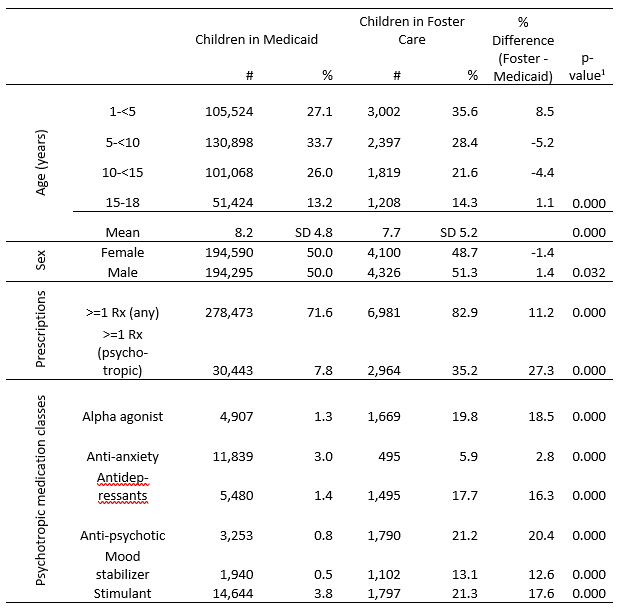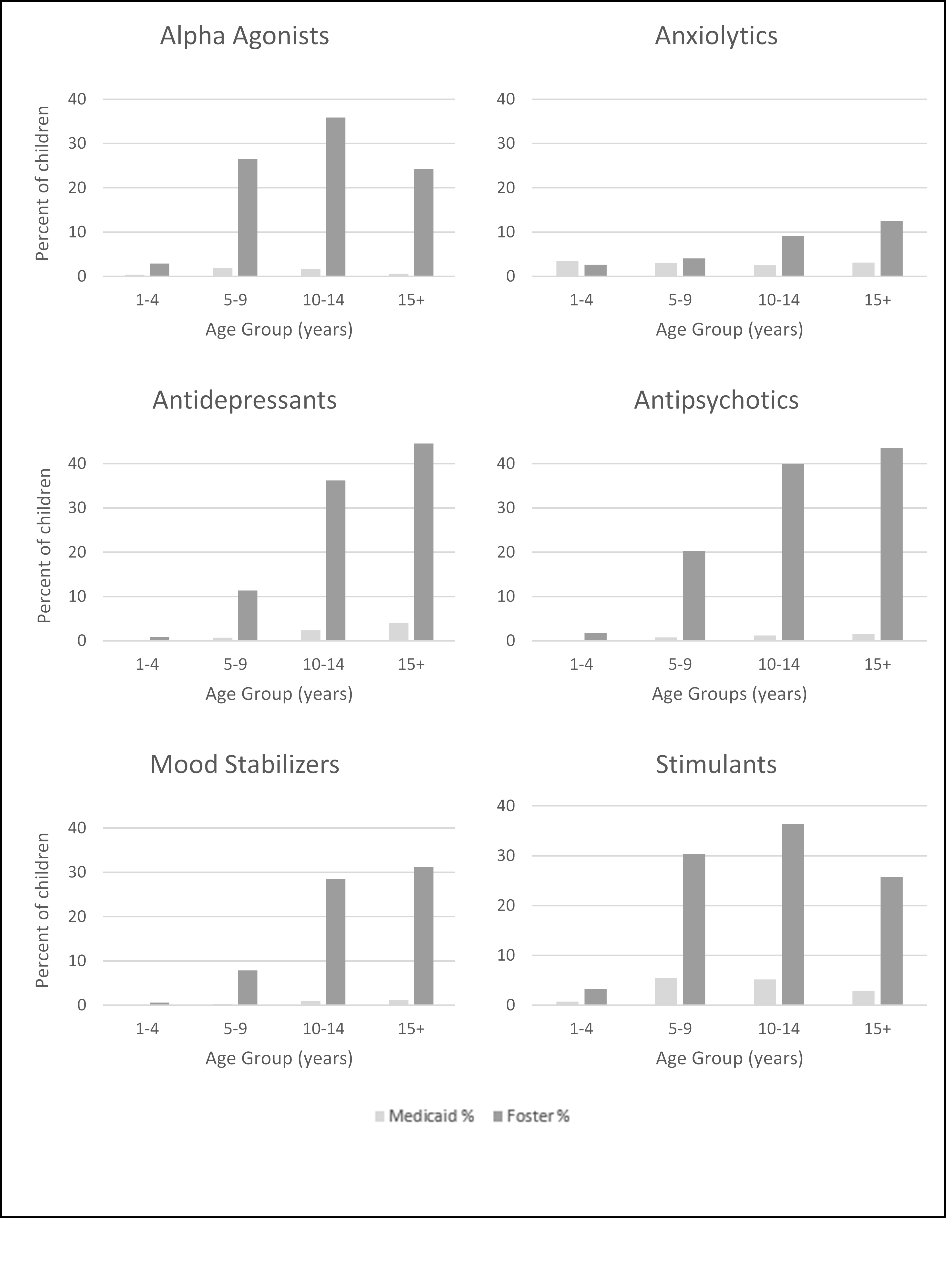Research to be presented at the 2021 American Academy of Pediatrics National Conference & Exhibition finds the prevalence of psychotropic medication use is 2-27 times higher among foster children in six drug classes, across all age groups.
ITASCA, IL – One in every three children in foster care are on psychotropic medications designed to alter their mental status or mood, a significantly higher percentage than children who are not in foster care within the Medicaid program.
That is one of the findings of a study abstract, “Psychotropic Medication Usage Among Foster and Non-Foster Youth on Medicaid,” that will be presented during the virtual American Academy of Pediatrics 2021 National Conference and Exhibition.
About 8% of children on Medicaid who are not in foster care are prescribed psychotropic medications, in comparison to the 35% of those in foster care, according to an analysis of Medicaid managed care organizations in southeast Texas. The dramatic differences in the prevalence of psychotropic medication use persist across all age groups, the research found.
“The overprescribing of psychotropic medications to children in foster care is something I feel every day in my clinical practice, but it’s different to see it on paper,” said the author, Rachael J. Keefe, MD, MPH, FAAP, medical director for Foster Care Clinical Service at Texas Children’s Hospital and assistant professor of pediatrics – public health at Baylor College of Medicine.
“It’s especially shocking to see these dramatic differences in children of preschool and elementary age,” Dr. Keefe said.
The study included 388,914 children in Medicaid and 8,426 children in foster care, ages 18 and younger.
Children in foster care were younger than children in Medicaid (mean age 7.7 years vs. 8.2 years (p<0.000), respectively).
The author analyzed records of those who had at least one healthcare visit generating a Medicaid claim from July 1, 2014 to June 30, 2016. Prescription medications were categorized into six classes: alpha agonists, anxiolytics, antidepressants, antipsychotics, mood stabilizers, and stimulants. Drug classifications were based on the primary indication as approved by the Federal Drug Administration or their primary use in child psychiatry.
Among children prescribed psychotropic medication, children in foster care are on medications in more distinct drug classes than non-foster children in Medicaid. Across six drug classes, the prevalence of psychotropic medication use is 2-27 times higher among children in foster care as compared to non-foster children in Medicaid,
This research was funded by a Texas Medical Center Health Policy Research Grant.
Dr. Keefe will present the study abstract at 4:15 pm Monday, October 11, 2021.
To request an interview, journalists may contact Dana Benson, director of communications at Baylor College of Medicine.
Please note: only the abstract is being presented at the meeting. In some cases, the researcher may have more data available to share with media or may be preparing a longer article for submission to a journal.
# # #
The American Academy of Pediatrics is an organization of 67,000 primary care pediatricians, pediatric medical subspecialists and pediatric surgical specialists dedicated to the health, safety and well-being of infants, children, adolescents and young adults. For more information, visit www.aap.org.
ABSTRACT
Abstract Title: Psychotropic Medication Usage Among Foster and Non-Foster Youth on Medicaid
Rachael Keefe
, , United States
Monday, October 11, 2021: 4:15 PM –
Previous studies report that youth in foster care covered by Medicaid receive psychotropic medication at a rate >3 times that of Medicaid-insured youth who qualify by low family income, but data on patterns of medication treatment for children in foster care are limited. While psychotropic polypharmacy, or use of multiple medications concurrently, is common in children in foster care, there is limited data to support its safety and efficacy. Out of this concerning trend, prescription monitoring guidelines and oversight rules were established, but are not uniform between states and are not well monitored. In this study, we compare psychotropic medication claims in children in foster care to children on Medicaid but not in foster care.
Healthcare claims data from two Medicaid managed care organizations (MCO) in southeast Texas were analyzed in this study – the largest MCO providing Medicaid coverage for children in the region and the single MCO providing Medicaid to children exclusively in foster care. The study included children age 1-18 years, enrolled in their respective MCO for 30 days or more, and who had at least one healthcare visit generating a Medicaid claim from July 1, 2014 to June 30, 2016. Prescription medications were categorized into six classes: alpha agonists, anxiolytics, antidepressants, antipsychotics, mood stabilizers, and stimulants. Drug classifications were based on the primary indication as approved by the Federal Drug Administration or their primary use in child psychiatry. Children with seizure and/or epilepsy diagnoses were excluded. Chi square, t-test, and Wilcoxon rank-sum analyses were used to compare outcomes between children in Medicaid and children in foster care. Comparisons were made overall and by age group.
Overall, 388,914 children in Medicaid and 8,426 children in foster care were included in the study. Children in foster care were younger than children in Medicaid (mean age 7.7 years vs. 8.2 years (p<0.000), respectively). Over one-third of children in foster care (35%) filled a prescription for a psychotropic medication as compared to 8% of children in Medicaid (p<0.000). By class and age group, the prevalence of prescriptions for psychotropic medications was higher among children in foster care (details provided in Table 1 and Figure 1). Among children who were prescribed psychotropic medications, prescriptions were filled for a mean of 1.4 (SD 0.78) and 2.8 (SD 1.4) (p<0.000) distinct drug classes for children in Medicaid versus children in foster care, respectively.
Children in foster care received significantly more psychotropic medications, overall, by age group, and by drug class. While claims data limit our understanding of the full context in which these medications were prescribed, this study demonstrates drastic differences in the use of these medications between children in Medicaid and children in foster care.
Overview of Psychotropic Medication Prescriptions of Children in Medicaid vs. Children in Foster Care

1p-value for chi square analysis for categorical variables and t-test for mean age
Percent of Children on Psychotropic Medication by Age Group
